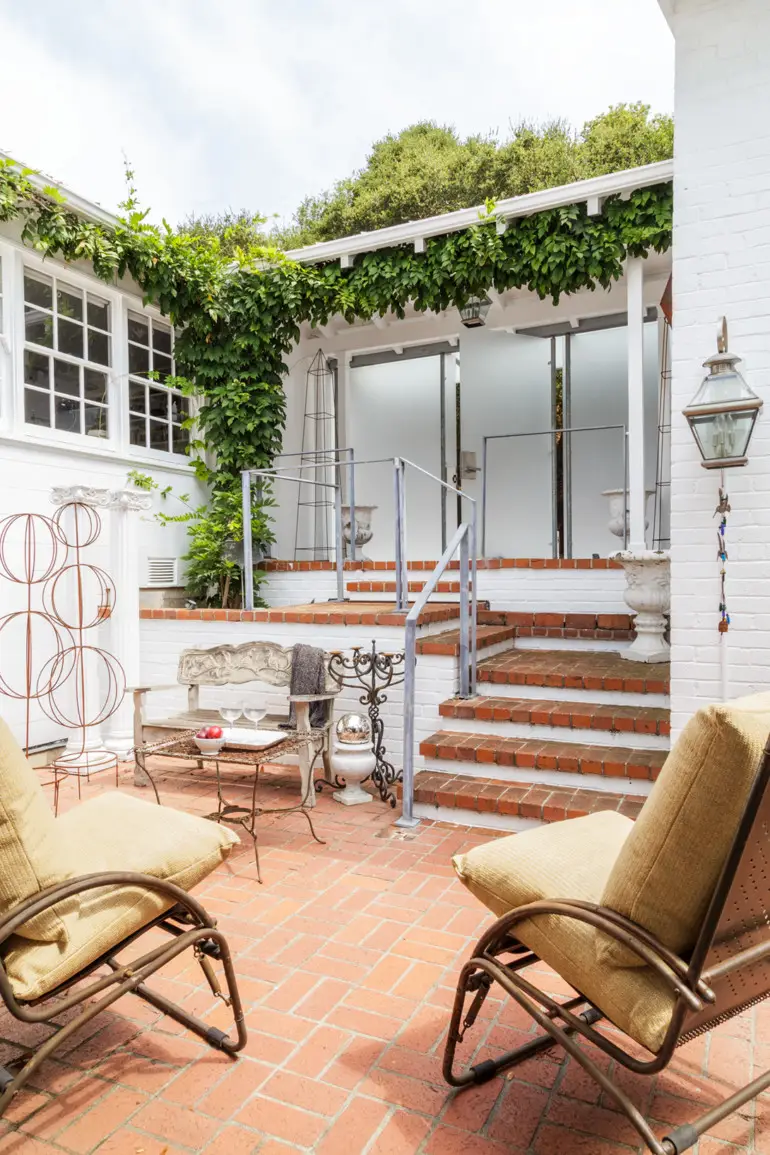At home, a painter collages together the loves of her life: art, books and childhood mementos.
FLOATING IN PAINTER ANN HARROLD TAYLOR’S colorful, textured canvases, words sometimes crop up like icebergs of meaning. A few of those paintings with their curious mnemonic handles appear in her peak-roofed cottage in the Berkeley hills, where her expressionistic outpourings share the walls with works by friends and mentors, including recognizable Bay Area artists such as Christopher Brown, Richard Diebenkorn and Robert Arneson.
“It is all uplifting for me. The art you surround yourself with becomes a surrogate teacher. The more you look, the more you see,” Taylor, who has also taught art at the Art Institute in San Francisco, explains.

foreground by artist Christopher Brown and, behind a marble bust, a blue and white jar by Berkeley ceramicist Robert Brady.
Originally from Sacramento, she returned there after she met her former husband at UC Berkeley, where she had studied art history and French. During college, a yearlong stint in France helped her develop a taste for Provençal food and culture, but all that went into hibernation during the time she was raising her son and daughter and commuting to UC Davis for an MFA under artist Wayne Thiebaud’s tutelage. When Sacramento felt like a cultural wasteland, she found sustenance in San Francisco and was represented there for a time by the Paule Anglim gallery.
Nonetheless, it was a tug-of-war, because “I also wanted to paint all the time,” Taylor says.
When she got divorced after 33 years of marriage, she was renting a large house designed by William Wurster in Berkeley. Finding an affordable painting studio and home nearby seemed the logical next step. “It was a way of moving forward toward my goal,” she says.
A North Berkeley warehouse became her atelier. And to meet a favorable tax break deadline, “I bought this 1980s house that belonged to a botanist and a history professor, in just seven days,” Taylor recalls. The 1,200-square-foot, two-story home was smaller than any place she had ever lived in, but she didn’t care. “I liked its bay views and the birds that came to visit it,” she says. “I love birds and it had great energy.”
With the help of Berkeley architect Andrew Fischer, she gave the L-shaped home and its separate street-side shed a unified contemporary facade, by adding a translucent glass gate between the two structures. A former covered entry porch is now the foyer, through which you enter a central open-to-sky courtyard that leads to the living and dining rooms and a large rear deck, also added on. That outdoor living space has sweeping bay views studded with the San Francisco skyline, the famous bridges, the leviathan new Salesforce tower and equally large cruise ships that sail by. A small kitchen and breakfast nook also open to the deck. On the right of the entry courtyard is a master suite. A set of stairs leads down to two spare rooms below the deck.
All the walls, inside and out, are painted a gallery white to emphasize the building’s shape as well as to make it seem larger.
In the dining area, eager to entertain in the manner she had always wanted — informally and surrounded by artist friends — “I tried to fit in as much seating as I could, facing the bay. It makes me happy,” Taylor says.


In the living room with exposed rafters, every surface does double duty as a place to eat or a counter for displaying treasured things. Oversize furniture, Biedermeier-style chairs from her old home and other mementos jostle for attention with an enormous TV monitor (for watching movies with her grown children) next to a fireplace with a voluptuous new white-painted mantel she designed. A comfortable old sofa invites viewers to lie down if they choose. Paintings of birds and carved bird decoys — some were gifts from her late father, an avid bird-watcher — are scattered among works by Taylor’s favorite figurative artists. Her own works, while largely abstract, sometimes conceal naïve renderings of flowers, hares, birds and even nests — perhaps as a nod to her love of nature — amid powerfully expressive blobs and streaks of paint.

The room is frequently refreshed with objects brought out of storage, as well as books of art and poetry that consume Taylor when she is not painting.
“I love living in something incomplete like this,” she says. “I no longer worry about whether my furniture needs to be covered, matched or perfect. I can add and subtract at will — just as I do when I paint. Not knowing what you are going to do next is endlessly interesting.”


This article originally appeared in Spaces’s print edition under the headline: “An Artist’s Progress”.

